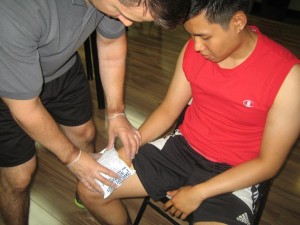A fishhook is a curved, sharp instrument that is placed on a lure or line in order to catch a fish. Some types of fishhooks have a barb near the tip that keeps the fish on the hook. Barbless fishhooks can also be used in order to minimize the chances of fishhook injuries.
[youtube url=”https://www.youtube.com/watch?v=-2Re91_P7KE”]Fishhook injuries occur when removing a slippery fish from the line, casting a line, when another individual is casting a line and walking barefooted near fishing gear. Remember that there is a higher risk for fishhook injuries if an individual is not familiar with fishing gear.
Fishhook injuries typically involve puncture wounds on the face, scalp, fingers, ears and even the back. A fishhook injury can be considered if the barb cannot be removed, injury is close to the eye, severe bleeding that cannot be controlled and large-sized wounds.
If the injury involves the interior structures, the affected areas will have the following symptoms:
- A pale, white, bluish or clammy skin
- Numbness and tingling sensation
- Diminished capability to move the affected area
- Development of infection with swelling, redness or drainage of pus. A wound from a fishhook that is dirty with the presence of bacteria can increase the risk of skin infection.

Treatment and home remedies
- Stop the bleeding and apply pressure on the wound for 15 minutes. You can learn measures to properly control bleeding by enrolling in a first aid class.
- You have to be familiar with the steps in removing the fishhook such as cutting the fishing line and apply an ice pack to numb the affected area and check if the barb is in the skin.
- Clean the wound after removing the fishhook using mild soap and water for 10-15 minutes.
- If the wound is large, deep and opens when moving, it requires stitches in a healthcare facility.
- Apply bandage on the wound to minimize the risk for infection.
Measures to carry out if fishhook injury is close to the eye
- Avoid removing the fishhook or applying pressure on the eye.
- Place a paper cup over the eye and tape it in place and avoid placing pressure on the fishhook or eye. Make sure that the uninjured eye is also covered.
- Seek medical attention.
What to do if fishhook injury on other parts of the body
- In case only the tip, not the barb is in the skin, all you have to do is to pull out the hook gently.
- If the barb is sticking to the skin and can be seen, cut off the barb with pliers and pull out the ends.
- If the barb is sticking to the skin and could not be seen, push the hook through the wound until the barb emerges. Cut and remove the barb and its shaft.
- Apply pressure using sterile gauze until the bleeding
- Rinse the wound using clean water for several minutes and then wash the affected area using mild soap and water.
- Provide the individual with pain medication and bring him/her to a doctor so that a tetanus shot can be administered.
